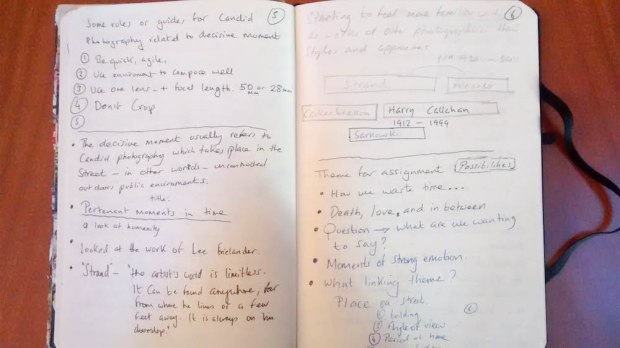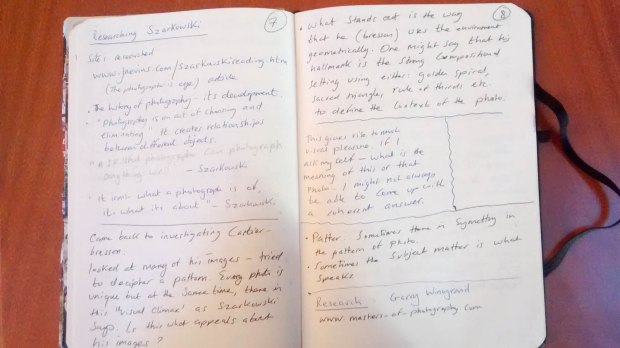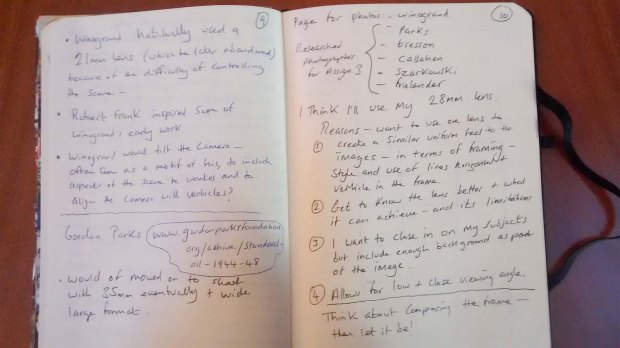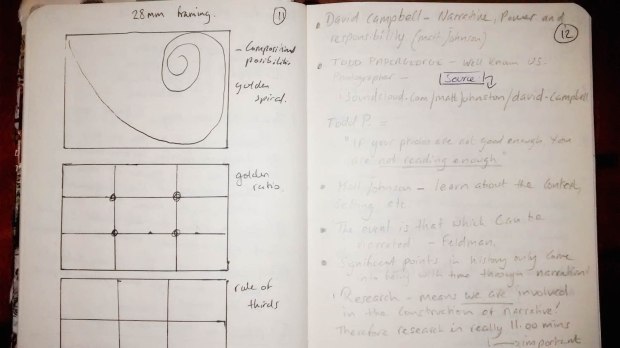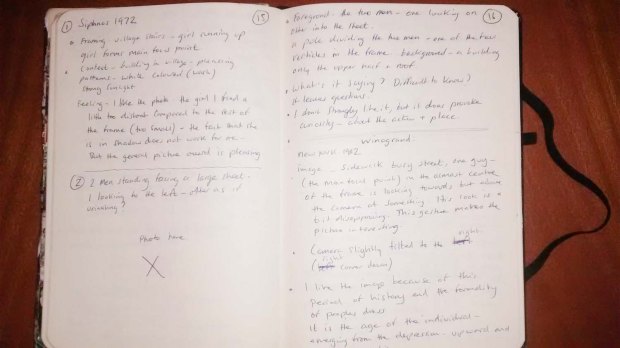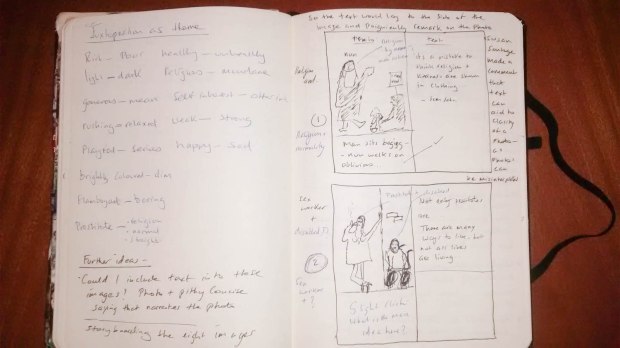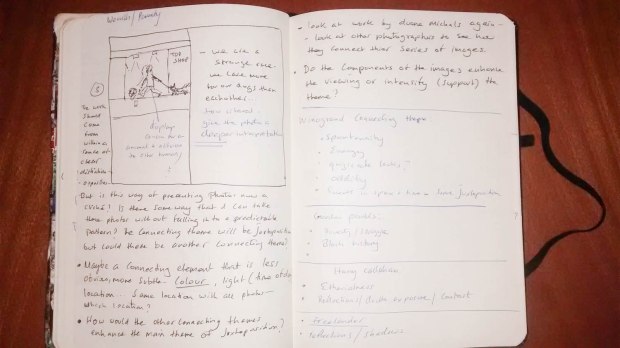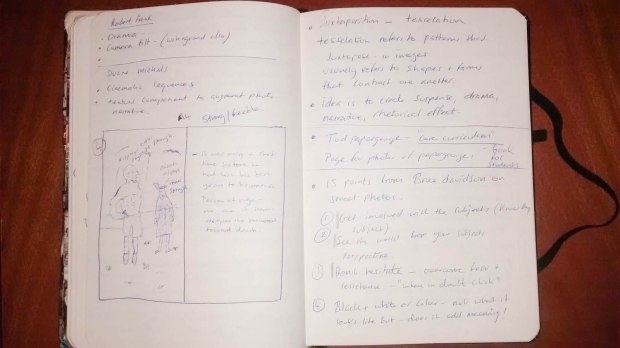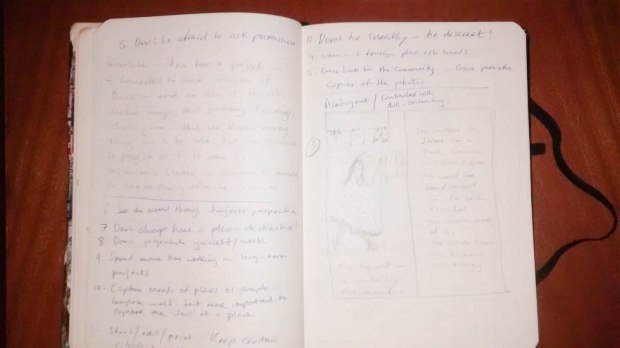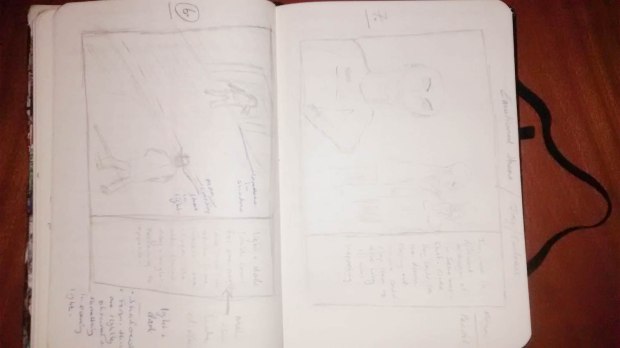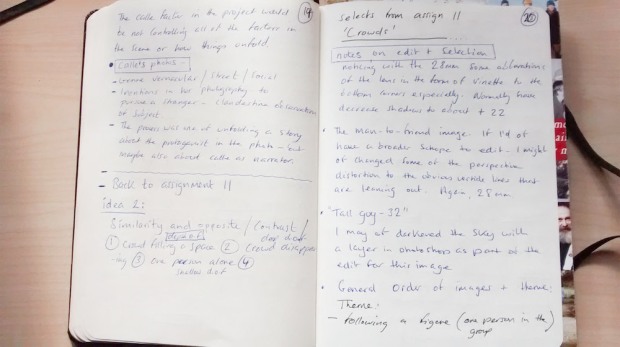Language of light-part4 learning log notes
*NOTE: The log notes format changes here so that they are clearer to read. I only include some pages that are scanned, mainly diagrams and drawings.
In this set of log notes, I am changing the format of how I present as previously it has been difficult to scan adequately and preserve eligibility of the notes. Instead what I will do is present the notes in a condensed form from my rough log book and only post up images of diagrams and drawing. The style of the notes is therefore a bit more mixed as I often interspersed reflections with quotes or questions and points. Chronologically it follows the actual way I wrote the notes up during part 4.
Exercise 4.1 metering:Experiments done here with light, dark and mid-tones reveal how camera measures and adjust to acquire 18% grey mid tone. Thus showing how there is a need to be creative in response to exposure setting and not always rely on the camera meter to perceive nuance.
Exercise 4.1


Notes/quotes from studying Joel Myerowitz
“You have to trust your instinct because you are your instinct as an artist”
“Many things draw us towards images that are just cliché because they are seductive but have no content”.
“It’s challenging to make a picture in the city-of the space-where things are disconnected but something must hold them together”
“One thing shows you the doorway to the next”
Reflections on Joel’s quotes
Im especially fond of the quote “One thing shows you the doorway to the next” as this reminds me of what happens in the creative process. It can seen as if nothing is moving and then suddenly all our energy gets ‘behind’ an idea or a vision to express something and doors open.
I very much like Joel’s attitude towards photography. Like many photographers of a similar genre and time, there is a philosophical underbelly to the photographers thought process and work. This can often feed into their work and produce fascinating images.
Sally Man’s photos/my reflections
Sally man’s images reveal quite a lot of emotion. Melancholy especially shows up as theme an a sense of passing time, death and the inevitable process of ageing.
She explores these themes well. One of her techniques is to use a non-coated lens of a full format camera. This gives the ghostly, eery and timeless feel to a lot of her images. There is sometimes the use of sepia in her photos too. She used these techniques to highlight something about the place she is in. She often shot her photos with her family in the ‘deep south’. Something here about timelessness or time not moving so quickly, slow-moving processes.
Micheal schmidt.
Schmidt offers ideas in his photos that are neutral and diffused in terms of the light. He claims that this offers the viewer greater objectivity in viewing and leads to an impartial seeing. He also shot in black and white to promote this sense of neutrality which he claimed is desirable for documentary photography. Whilst I see his point, I also think that this is just one point of view and not an absolute statement about documentary photography and the use of light.
My reflections on Schmidt
The camera has many voices and I think that it is almost certain that any photography will have some degree of subjectivity to it-even if it is just the composition and the angle of the camera. I doubt that any photograph taken intentionally by a pro can be purely objective. Most of the time photographers take photos with the conditions of the photo in mind such as light, place, angle of view, composition of content etc. Therefore, the idea of ‘remaining neutral’ I find somewhat questionable.
The way in which the exercises helped guide assignment 4
All of the exercises in Part 4 have in some way influenced my final assignment. To start with we looked at exposure in 4.1 This guided me to experiment with exposure and effect. With my assignment I had at first underexposed the images. Although I was aiming for dark tones and a low light set of photos In fact the underexposure did not help with the expression of the theme. So, I needed to learn that dark tone photos and the type of images that I have produced might be a bit different in effect.
In project 2 Sally Mann’s work also inspired to some extent the vision of making the photos that I made. However, later I realised that she was not the best influence for the studio work that I wanted to do. However, her otherworldly use of light greatly inspired me. Her ‘non-coated’ lens look can be reproduced by putting a plastic bag over the lens with a good whole in the centre. Perhaps at a later date I will see if I can emulate her and do some sepia photos in this way.
Exercise 4.2 made me think about hues of light and how daylight can change the appearance of the subject quite forcefully. Each time of day seems to have almost a certain emotional quality that it evokes.
Project 3 Lekic’s photo was major source of reflection and formed in a way the basis for the assignment along with the image Ophelia by Gregory Crewdson. Both Crewdson and Lekic provided a technical basis for developing my own project. In Lekic’s photos it was the focal points of light (windows) in the darkness that made me think of faces in the dark, of people coming out of or going into ‘dark spaces’ and moods. Although my photos have a lot of colour in them and cannot be seen to be wholly nihilistic, still the ambient of dark tones supports the work and the mood.
Exercise 4.3 Ambient light in the street at night taking photos under phosphorus lighting was a good exercise for working to expose at night under artificial light conditions. A light that is so different to daylight.
Exercise 4.4 shooting artificial light is about the time that I decided to do the studio project for the assignment. Partly this sparked my deep urge to learn more about artificial light and how to control and use that to optimum effect. I used a log in a darkened studio to explore mood and it was here that I saw what I wanted to do for the assignment.
So on the whole the exercises provided a clear build up that led into the assignment in this case. I felt I learned a lot about lighting in general whilst going over again some old knowledge and clarifying that.
Exercise 4.2
Diagrams of camera position with some details about the shooting for exercise 4.2


Beginning some research on lighting
Subject lighting
Micheal langford – basic photography (1997) focal press.
- 6 features of lighting :
- Quality
- direction
- contrast
- evenness
- colour
- intensity
Quality: concerned with shadow, i.e. hard or soft, clear etc. Types of light also: diffused or hard etc.
Direction: Direction of light effects how we mould the light to the subject. It is also a language in itself in that it changes the emphasis to what you are photographing. See my exercise assign 4 for more on this.
Contrast: Lighting contrast is the light that hits the illuminated parts and the shadow parts of the object. Typically sensors of digital cameras cannot gauge very well the distinction as well as we see with our eyes.
Changes in metering are often necessary to accommodate for strong back-lit situations or dark.
Evenness: Depends upon light source and distance ratios. Ratios are this: 1:4 (1mtr) 1:2.3 (2mtrs) 1:1.7 (3mtrs)
Intensity: Intensity is controlled by exposure settings and lighting levels can effect depth of field in the image.
Exercise 4.3
We explore artificial light here. I have taken several sequences of images and for the course submitted some that I did on the street on a village in the south of Spain. Artificial light is in the form of sodium street light can give a cast that is orange and somewhat undesirable. Below are diagrams of exercise 4.4 (studio light with a log).
Exercise 4.4
These are diagrams of the studio set ups I used to do exercise 4.4
5 images shot for the exercise.
Back to Langford M. Discussing light intensity
In this section Langford discussed the issue of light drop off in relations to distance of subject to lighting distance. This is an interesting and relevant area both for studio and field work in photography.
The diagram shows the distance of lighting to object drop of in ratios.

So we work with light intensity by either changing the distance of the light to the subject or by changing light intensity from within the light source by powering up or down the units that we are using.
Basic formula:
- Small light source close – high contrast uneven
- small light source further away- less contrast more even
- larger light source diffused close in-even soft light
- larger light source further away, harder light.
Quotes from Gary Winogrand
“Photography is about transforming the ordinary into something different not making pretty pictures”
“You don’t learn by repeating what you already know”
“Risk failing every time that you make a frame”
Reflections on Winogrand
Winogrand for me is one of the grand masters of street photography. He is a sort of renegade rebel with a camera in his hand out to make photos. one of his famous ideas is that the idea narrative on photos is a complete fallacy. Its impossible to know what is taken place in a photo as you only have a snippet of a frame and its not possible to say quite what is taking place and why. So therefore, no narrative. I’d agree to a point but I think that there is room for debate there. For example, a series or sequence can be more strongly narrative and therefore portray a story well. I think it depends.
“Photography is about transforming the ordinary into something different not making pretty pictures” Yes I am beginning to see the truth in this. This transformation suggests a certain alchemy with the camera. That actually pretty pictures don’t stick, what sticks is a memorable image that resonates with us. Many of winogrands images do stick with me… and some even seem to begin to transcend the ordinary and become somewhat magical.
Ideas for exercise 4.5

Here in exercise 4.5 I explore using a map, some ideas for the project.
Development of these ideas: walk around and see how things affect me, contrary to the popular or typical emotional responses or expectations of things or objects. Be alive to how I am influenced by my environment.
Reflections on this exercise.
On the whole I have made good use of this exercise to think outside of the box and further afield. To start with it made me think about the proliferation of images in the world and how a great many are simply for the sake of prettiness and without a lot of meaning. This is especially the case with a lot of advertising and such. The idea is to glorify and hype up something so that it appears desirable. To make someone react with a purchase.
Photos with commercial orientations such as the above mentioned have but one purpose but are almost throwaway, and not made to last. This is a sign of our times. The throw away culture that we live in promotes wastage and superficiality.
So when I went searching the object or situation my mind was looking more to show the other side of the coin in a more realist manner. Hence my photo from the inside out, or a ruin, with the sense of beauty more incidentally placed into the photo but outside through the window.
Researching assignment 4 (see assignment 4 research for more)

On this page begins my planning for assignment 4 which I had chosen to base on studio lighting. These ideas, as is often the case with my pre-stage thinking, change and things develop.
I have spoken about the route I took and why, in my assignment so I won’t repeat that here. I chose as a theme to create a narrative out of 8 images using studio light to emphasis, drama, emotion and give emphasis to the characters’ emotion.
below you’ll see the pre-shoot sketches that I regularly do before taking photos.
These are the sketches (not all) for the scenes that I produced before shooting. They are not all there because some I created on the day of the shoot. They do not follow any particular order.
You will see that both some of the ideas of the original scenes and the actual shots have changed. But for the this pre-shoot visualising and scribbling have become an indispensable part of my planning for any assignment nowadays. It is a premeditation within which ideas form and then get consolidated so it is rather important.
Interlude for doing some test shots
I want to do some test shots because I feel that I need to see both how I need to measure the light by turning my phone into an incident light meter and because I want to pre-visualise the scenes that I will shoot. I need to see what I am doing before hand. Not only that I feel that I need to get a sense of the camera set up and what shutter speed to use and ISO.
I’ve decided to tie together the photos with a theme that will be a story. I need to make it into a story that tells a relatable and believable picture tale. It will be about love and the end of it. Everyone can related to that!
It would be good to be more nuanced and subtle about it. But I think that with this shoot I’ll be more suggestive and direct as primarily I want to practice lighting. The story telling can come at some other time.
Things to consider for the shoot.
- Several LED lights will be needed to multi light the scene
- When (if) I use flash I’ll need to make the necessary steps to balance up the white with the different lights (as it happening I did not use flash in the end)
- One main lamp and one smaller lamp. The actual lamp in the photos will be ‘self lit’ using the led from my mobile phone. This won’t cast any light into the scene or very little.
- Shoot some images with 85mm on my full frame and others with 35mm in the fuji film pro1.
- Test shots came up as: auto-white balance, f/2.8 1/15 second (actually 1/20 1/50 were used on the day) and ISO 200-320.Did some activities to practice lighting: Child J. & Galer M. (2008) photographic lighting, focal press.
- Key light and fill light considerations.
- Considering the issues around working in a low key dark tone environment.
I used two photos by two photographers for my research and my influence for assignment 4. This can these can be found on the assignment 4 page and the assignment 4 research pages. I also did analysis of my own images which one can see on the research page.
During the test shots I also did some activities to practice gauging the light needed for the shoot.
Exercise 1.
- Place a light 1mtr from the wall and measure the light with incidental light meter (my mobile app)
- Then move the light back 1mtr, re-measure
- Move the light back 2mtrs more and re-measure.
Finding were obvious. There is a 4 stop drop off in light intensity from 1-4 mrs. This experiment proves the need to observe adjustments to light when moving objects and light around in a studio as we can quickly alter the intensity of light without being aware.
Exercise 2.
- To look at shadows and diffusion place a light near to the object with diffusion 1mtr from the light
- Place the light further back with diffusion closer to light source
- Remove the diffusion and experiment with near and far distance to object to perceive harder shadows
The diffusion acts to throw a softer light thus giving softer shadows onto the object, the no diffused light naturally produced a harder shadow, more intense and delineated.
General notes on dark tones and light tones and metering for them.
The camera’s TTL meter will record dark tones as mid tones, mid tones will be recorded as light tones and light tones overexposed.
If light tones are dominant: Light tones get recorded as mid-tones, mid tones as dark tones and dark tones get underexposed.
This is a useful little formula to bear in mind when one is shooting under any circumstances so that we can adjust the camera’s exposure compensation to achieve better results in the camera. Any lack of lighting into the dark tones cannot be made up post shoot. If the data is not there that’s it. Therefore good to bear in mind.
Problems with shooting in low light conditions are numerous. One issue is that of excessive noise if we use hight ISO. The other is banding, again due to lack of light into dark tone areas of the frame.
So the trick is to do a good exposure in the camera when there are dark tones and in post edit one can reclaim the detail in the dark tones.
Exploring Crewdson and Lekic’s photos. This I have done in the research section. Assignment 4 research
Why dark tone images appeal to me
Essentially it comes down to mood. I really love the way in which one can see light more clearly enhanced in dark tone or low light photos. My series of images for this assignment are essentially an exploration of the that to quite an extreme in the sense that I wanted very little to be lit, mainly the main subject. The background in some of the images is merely suggested. This was intentional.
On balance I prefer to work with dark tones and shooting in low light. I also like to use the fill flash technique in low light conditions for subjects that can be interestingly brought into relief with the use of a puff of flash light to enhance the scene.
My viewing of photographers such as crewdson, Michals, Lekic and others have inspired that way of looking at light within predominant dark tone atmosphere. Also the work of Philip lorca di Garcia inspired this vision of dark tones with an illuminated subject in the midst. You can see his ‘heads‘ series for a fuller view of this. I think that dark tone/low light can be highly expressive if used well. It can communicate in a nuanced way much emotion.
David Prakel’s advice on keeping a record and log of studio set ups. He recommends keeping set up notes on the following:
- Subject
- background
- Camera
I would include also in my log a good record of post production work so that this could be saved and used in similar creative situations in the future.
A look at composition..some reflections
compositions is complex because the rules can change and the photo can still work. So why do we have rules of composition? Because we need to train the eye and because we need the discipline of compositions to be able to branch out and explore. However, being slavish to composition isn’t the point. That type of photographer abounds. There is fear of getting it wrong so they play safe by the rules. But this is not creativity as I see it, this is slavish adherence to a rule. However, it would be loose and poor form to ignore composition. I think its like any discipline, one has to learn the work, the masters and then you might be in a position to start to call yourself independent at some point. But we have to ‘cut our teeth’ first.
So, I reviewed composition just to remind myself how to look at an image through the viewfinder. I find its worth coming back to basic at times. It more like a spiral than a circle in that there is retiring but climbing up at the same time, it’s the same old thing as before. Looking more deeply in to the subject you learn new things as there is no finite point. No end goal.


These diagrams are copied from David prakel: Basic composition (2006) AVA publishing
Pre-visualise the scene before shooting/ reflections
Before taking any image learn to pre-visualise it in the mind’s eye perhaps before even looking through the viewfinder. This can help a great deal to enhance the outcome of what we are doing and shooting.
Creative thinking leads to creative work. As I said in assignment 4: “if you can’t visualise it how can you shoot it!” Therefore spending time thinking about the scenes and the images works. As I have been doing this subconsciously and more consciously with this assignment I think that it has paid off.
Analysis of images for assignment 4
The images for assignment two consist of a story of sequence narrative (mildly cinematic) that depict the end of a love affair. There are two main protagonists. The photos are done in a dark tone low light setting, within a studio. The use of spot lights have been used to help create emotion and atmosphere. I wanted to push myself here so I created a situation that was a bit of a challenge.
The first image has three main focal points, one plane and a relatively balanced symmetry in terms of the layout of the frame. The lighting is stronger to the face of the character than to the other points within the frame which was intentional. There are mainly vertical lines within the frame or at least implied vertical lines. The angle of camera is to one side and low. The photo was shot with a 35mm fixed lens at full aperture f/1.4
The second image, a man lying in bed, has two focal points and two planes. The background shows a picture frame turned around which suggests a rejection of someone. The man weeps, and the image mainly focuses on this. The failing in this photo might be that the face is too far from the camera. It may have worked to have filled the frame more with the head such as with the face of the female that has a full portrait in the frame. This could have helped consistency for the sequence as I wanted to show both faces within the sequence to highlight their feelings.
The third image shows a man leaving a through a door. The end result of a broken relationship. The light is thrown mainly onto his frontal body leaving the back in darkness. The fault here is that the reflection (fill light) did not reach sufficiently the back of the head thus it is too obscured. The lines are strongly vertical and there are two parts of the picture. The door and the man. Undoubtably this image could have been set up and dramatised in a better way. I went in a sense for a more simplistic image as I was looking to portray the light. The light in this scene in retrospect does not quite work as I might liked it to of done. It gives the impression that he is in the headlights of a car rather than a more softer diffused light to create a solemn mood, which was the aim. To shoot this again I would aim to produce a softer even light on the figure.
(image 4 is image 5 in the sequence) So the next photo is of a woman now finding the letter that the man wrote and having her initial reaction of dismay. This is my favourite image of the whole sequence and the light (although could have been softer by moving the light further away) serves to emphasis her form and beauty. The light is a bit heavy but it fits in with the sequence overall. The draws to the other side of the frame should have been lit more. There was small LED pointing towards them from the side, but it has not given sufficient light. When I explored putting the light in another place it created hot spots in the camera as the direct light was too strong.
Picture five, we see the face of the woman close in. She is shocked or grieving (one of the two!) directing actors is difficult as they don’t always produce quite the subtly emotional states that one might like. The light is gentle and shows mainly her face leaving the hair somewhat in darkness and darker tones. Between her arm and her face there is a narrow implied triangle which makes the picture a little more dynamic. The arm on the head emphasises her grief.
The next two photos (6&7) show scenes or stages of the impact of what has happened i.e postures of grieving. I decided to shroud her mostly in darkness and frame one eye in light and have most of her face in dark shadow. This exaggerates quite a bit the situation. However, it says in the book- Basic composition: “exaggeration is one of photography’s most powerful tools” Prakel D. (2007:100). Picture 6: Main focal point the woman’s half lit face doubled on the chair. background, the lamp which provides a suggested context or place i.e a living place. The light is too strong between light and shadow and it would have been good to of used a fill light (reflector) to distribute some light to the other side of her face and body. The light is a bit too one-sided. As for portraying a mood I think this happens quite well. She is increasingly showing signs of resignation. A sort of falling into herself.
Image 7: here I placed the model in the supine position because it’s seemed like the ultimate posture of resignation. The focal points are her face and principally her hand whereby she has cigarette. The angle of view is low and the frame is mainly filled will her torso and lower body flowing in and moving across the frame. I was aiming here to give a sense of the feminine, curving and gently moving out of the frame. The lines are mainly horizontal although the position of her hand dropping down and he lamp at the back offer some verticality in the picture. The cigarette was aimed to be the main focal point.
Image 8: Resignation turns into rejection as she burns the letter from the ex-lover. Here the lighting and posture changes. There is a more open sense to the photo. For this image I used the light bound off of the ceiling because I wanted to bring more light generally into the scene as if to say things will be alright. However, I am not that happy with the lighting. The effect of the overly lit parts of the frame and dark surrounding don’t quite work as well as I had imagined. On reflection it could have been good here to of bounded flash off of the ceiling as I could have controlled the diffusion more and softened the tones a bit. This is however an idea, one that unfortunately I did not try on the day.
This concludes my log notebook for part 4 of the course.





























